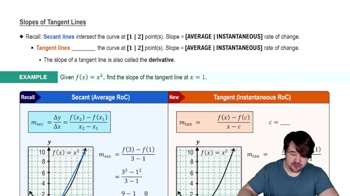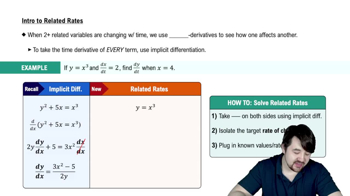The National Weather Service releases approximately radiosondes every year to collect data from the atmosphere. Attached to a balloon, a radiosonde rises at about ft/min until the balloon bursts in the upper atmosphere. Suppose a radiosonde is released from a point ft above the ground and that seconds later, it is ft above the ground. Let represent the height (in feet) that the radiosonde is above the ground seconds after it is released. Evaluate and interpret the meaning of this quotient.
Table of contents
- 0. Functions7h 54m
- Introduction to Functions16m
- Piecewise Functions10m
- Properties of Functions9m
- Common Functions1h 8m
- Transformations5m
- Combining Functions27m
- Exponent rules32m
- Exponential Functions28m
- Logarithmic Functions24m
- Properties of Logarithms36m
- Exponential & Logarithmic Equations35m
- Introduction to Trigonometric Functions38m
- Graphs of Trigonometric Functions44m
- Trigonometric Identities47m
- Inverse Trigonometric Functions48m
- 1. Limits and Continuity2h 2m
- 2. Intro to Derivatives1h 33m
- 3. Techniques of Differentiation3h 18m
- 4. Applications of Derivatives2h 38m
- 5. Graphical Applications of Derivatives6h 2m
- 6. Derivatives of Inverse, Exponential, & Logarithmic Functions2h 37m
- 7. Antiderivatives & Indefinite Integrals1h 26m
- 8. Definite Integrals4h 44m
- 9. Graphical Applications of Integrals2h 27m
- 10. Physics Applications of Integrals 3h 16m
- 11. Integrals of Inverse, Exponential, & Logarithmic Functions2h 31m
- 12. Techniques of Integration7h 41m
- 13. Intro to Differential Equations2h 55m
- 14. Sequences & Series5h 36m
- 15. Power Series2h 19m
- 16. Parametric Equations & Polar Coordinates7h 58m
0. Functions
Introduction to Functions
Problem 77
Textbook Question
In each exercise, a function and an interval of its independent variable are given. The endpoints of the interval are associated with points P and Q on the graph of the function.
a. Sketch a graph of the function and the secant line through P and Q.
b. Find the slope of the secant line in part (a), and interpret your answer in terms of an average rate of change over the interval. Include units in your answer.
After t seconds, an object dropped from rest falls a distance d=16t2, where d is measured in feet and 2≤t≤5.
 Verified step by step guidance
Verified step by step guidance1
Identify the function given: d(t) = 16t^2, where d is the distance in feet and t is the time in seconds. The interval for t is [2, 5].
Sketch the graph of the function d(t) = 16t^2. This is a parabola opening upwards, and you should plot points for t = 2 and t = 5 to find the corresponding points P and Q on the graph.
Calculate the coordinates of points P and Q. For P, substitute t = 2 into the function to get d(2) = 16(2)^2 = 64, so P is (2, 64). For Q, substitute t = 5 into the function to get d(5) = 16(5)^2 = 400, so Q is (5, 400).
Find the slope of the secant line through points P and Q. The slope m is given by the formula m = (d(t2) - d(t1)) / (t2 - t1). Substitute the coordinates of P and Q: m = (400 - 64) / (5 - 2).
Interpret the slope of the secant line as the average rate of change of the distance with respect to time over the interval [2, 5]. The units of the slope are feet per second, indicating how fast the distance changes on average as time progresses from 2 to 5 seconds.
 Verified video answer for a similar problem:
Verified video answer for a similar problem:This video solution was recommended by our tutors as helpful for the problem above
Video duration:
6mPlay a video:
Was this helpful?
Key Concepts
Here are the essential concepts you must grasp in order to answer the question correctly.
Secant Line
A secant line is a straight line that intersects a curve at two or more points. In calculus, it is often used to approximate the slope of the curve between those points. The slope of the secant line represents the average rate of change of the function over the interval defined by the two points. This concept is foundational for understanding the transition to the derivative, which represents the instantaneous rate of change.
Recommended video:

Slopes of Tangent Lines
Average Rate of Change
The average rate of change of a function over an interval is calculated as the change in the function's value divided by the change in the independent variable. Mathematically, it is expressed as (f(Q) - f(P)) / (Q - P), where P and Q are the endpoints of the interval. This concept is crucial for interpreting the behavior of functions over specific intervals and is a precursor to the concept of instantaneous rate of change, which is defined by the derivative.
Recommended video:

Intro To Related Rates
Graphing Functions
Graphing functions involves plotting points on a coordinate system to visually represent the relationship between the independent and dependent variables. Understanding how to sketch a graph is essential for visualizing the behavior of functions, including identifying key features such as intercepts, slopes, and curvature. This skill is particularly important when analyzing secant lines and their slopes, as it provides a visual context for the mathematical concepts being applied.
Recommended video:

Graph of Sine and Cosine Function

 1:36m
1:36mWatch next
Master Introduction to Calculus Channel with a bite sized video explanation from Patrick
Start learningRelated Videos
Related Practice
Textbook Question
3
views
